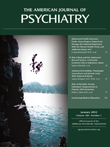Overexpression of Chromosome 15q11-q13 Gene Products: A Risk Factor for Schizophrenia and Associated Psychoses?
To the Editor: We read with interest the article by Ingason et al. (1) in the April 2011 issue of the Journal. Their results suggest that the presence of an extra (maternal) copy of a fragment of chromosome 15q11-q13 that overlaps with the Prader-Willi/Angelman syndrome critical region may be a rare risk factor for schizophrenia and other psychoses. We report three cases with the infrequent isodicentric chromosome 15 (idic[15]) syndrome (2), a condition that results in partial tetrasomy 15q and schizophrenia.
Case Reports
“Ms. A” was a 17-year-old woman with mild intellectual disability (IQ=56), recurrent psychotic episodes (incoherence and haptic and auditory hallucinations), and complex partial epilepsy (lip smacking with bilateral EEG abnormalities). Conventional karyotyping and fluorescence in situ hybridization analysis using probes from both proximal chromosome 15 and the Prader-Willi/Angelman syndrome critical region revealed an isodicentric chromosome 15 (47,XX,+idic[15]). Unfortunately, the parental origin of the isochromosome was unknown. After unsuccessful treatment with risperidone (6 mg/day), we administered clozapine (400 mg/day, plasma level=0.096 mg/liter, therapeutic levels=0.20–0.60 mg/liter) and carbamazepine (600 mg/day, plasma level=8.0 mg/liter) with good response.
“Ms. B” and “Ms. C,” 43-year-old apparently monozygotic twins, were both diagnosed with mild intellectual disability (Ms. B's IQ was 63, and IQ was not available for Ms. C) and schizophrenia of disorganized type. Both twins developed their first psychotic symptoms at age 25. Medical records indicated that their mother and father were disabled. Additionally, the father was diagnosed with schizophrenia. Karyotyping and fluorescence in situ hybridization revealed 47,XX,+idic(15). The mother had the same karyotype, while their father's karyotype was a normal 46,XY. Over the years, multiple psychotropic drugs were prescribed with unsatisfactory results in both women. At age 41, Ms. B was treated with clozapine (350 mg/day, plasma level=0.35 mg/liter). Her overall functioning improved substantially, and her psychotic symptoms diminished. Therefore, Ms. C was also switched to clozapine (100 mg/day, plasma level=0.36 mg/liter). Although clinically we observed no significant change in Ms. C, the number of psychotropic drugs in her regimen was reduced from five to one.
Discussion
To our knowledge, these are the first reported cases of both idic(15) syndrome and schizophrenia. These cases provide further support for the supposed association between the 15q11-q13 region and schizophrenia and associated psychoses through the overexpression of (maternal) genes in the region (1). In addition, these cases suggest that clozapine should be considered in treating psychoses associated with idic(15) syndrome.
1. : Maternally derived microduplications at 15q11-q13: implication of imprinted genes in psychotic illness. Am J Psychiatry 2011; 168:408–417Link, Google Scholar
2. : The behavioral phenotype of the idic(15) syndrome. Am J Med Genet C Semin Med Genet 2010; 154:448–455Crossref, Google Scholar



